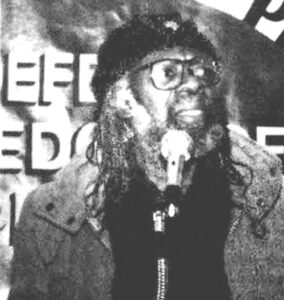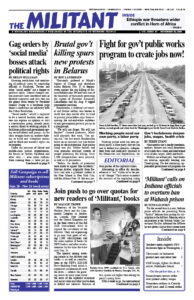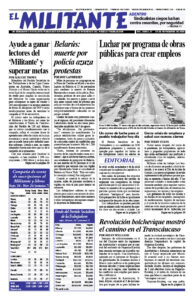ATLANTA — “The Pathfinder Mural proudly stood as a beacon of hope for all who had the good fortune to see its light,” artist Cliff Joseph said at a June 1996 meeting marking the nearly 10-year history of the mural. Joseph was part of an international team of artists who painted the six-story celebration of working-class struggles around the world on the walls of the New York City building where Pathfinder’s offices and print shop were located.
Joseph died in Chicago Nov. 8. He was 98.
His keen sense of the injustices of capitalist rule began early in his life, an obituary from the Aaron Galleries in Glenview, Illinois, which handles his works, makes clear. After witnessing the horrors of war while in the army, he concluded that soldiers on the other side are “more like us than different.” That observation greatly influenced the anti-war subject matter of his artwork.
From 1987 to 1989 some 80 artists from 20 countries worked on what was popularly known as the Pathfinder Mural Project. The finished mural depicted a large printing press turning out literature surrounded by paintings of revolutionary fighters and historical working-class battles. The paper coming out of the press quoted Cuban revolutionary leader Fidel Castro, “The truth must not only be the truth, it must also be told.”
Pathfinder publishes the speeches and writings of Socialist Workers Party and other revolutionary working-class leaders, including Castro, Che Guevara and Vilma Espín, leaders of the Cuban Revolution; Nelson Mandela, the central leader of the fight that overthrew apartheid in South Africa; Black rights fighter and working-class revolutionary leader Malcolm X; Thomas Sankara and Maurice Bishop, who led popular revolutionary governments in Burkina Faso and Grenada; Karl Marx and Frederick Engels, founders of the modern communist movement; U.S. working-class and Socialist Workers Party leaders James P. Cannon, Farrell Dobbs and Jack Barnes; and V.I. Lenin, Leon Trotsky and other leaders of the 1917 Bolshevik Revolution.

Finishing military service after the second imperialist world war, Joseph studied art at Pratt Institute in Brooklyn, New York, graduating in 1953. He was the first African American member of the American Art Therapy Association.
Joseph was a co-founder of the Black Emergency Cultural Coalition, which worked to promote works by African American artists. The group was formed in 1969 in response to a Metropolitan Museum of Art showing entitled “Harlem on My Mind,” which disregarded the work of several prominent Harlem artists.
In 1963 Joseph and his wife, Ann, attended the March on Washington, where Martin Luther King Jr. was one of the featured speakers. Joseph painted a portrait of the civil rights leader in the mural, and another of Steve Biko, a leader of the fight against the apartheid regime in South Africa.
Among Joseph’s many works is a 1972 painting “The Attica Crucifixion,” which depicts a prisoner behind bars of crosses. On Sept. 9, 1971, prisoners took control of part of Attica prison in upstate New York and held several hostages in order to negotiate for better conditions. Their slogan was, “We are men. We are not beasts, and we will not be driven as such.” Four days later, on orders from the governor and prison officials, hundreds of heavily armed state cops and prison guards assaulted the prisoners, killing at least 29 of them and 10 hostages.
Joseph was an early and steadfast supporter of the Mural Project. In January 1988 he secured the gallery of Westbeth Artists Housing in Manhattan’s Greenwich Village, just a few blocks from the mural site, for a meeting of 100 to protest an attack on the project by city authorities.
‘Power of art belongs to the people’
“We’re involved in a fight, but I believe the mural is going to be completed. We’re not going to let anyone prevent that from happening,” Joseph said at the meeting. “The power of art belongs to the people. I think the establishment knows the power of art and what it can mean to a people in their struggle against oppression.”
In the high-tempo final weeks of its completion, artists from Cuba, Canada, Argentina, South Africa, Iran, New Zealand and other countries were plying their skills on the wall. When I expressed my concern about completing everything on time, Joseph replied that all those people working together showed the power of this project. “We’ll get done,” he said.
By 1996 the mural and the wall it was painted on had irreversibly deteriorated from sun and weather damage. The mural had to be removed in order to repair the building.
Many in Greenwich Village and beyond remember the mural. A Sept. 24 article posted at VillagePreservation.org concludes, “Despite the controversy, many supported and admired the mural, including workers and neighborhood residents.”
Joseph recalled the time when the mural was attacked by the editors of the New York Post and right-wing columnist Patrick Buchanan in 1989, and later vandalized with paint bombs. “There are those who opposed its message,” Joseph said. “Today, Pathfinder is organizing its honorable removal with the carefulness and love in which it was created.” Those of us who shared in that work will always remember his example.
Sam Manuel was the director of the Pathfinder Mural Project.


